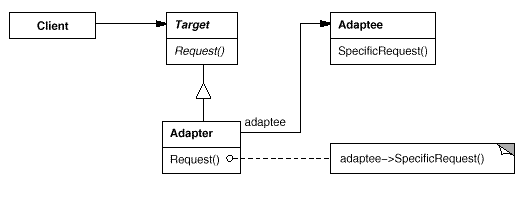| 名稱 |
Adapter
|
| 結(jié)構(gòu) |

? |
| 意圖 |
將一個(gè)類的接口轉(zhuǎn)換成客戶希望的另外一個(gè)接口。A d a p t e r 模式使得原本由于接口不兼容而不能一起工作的那些類可以一起工作。 |
| 適用性 |
- 你想使用一個(gè)已經(jīng)存在的類,而它的接口不符合你的需求。
- 你想創(chuàng)建一個(gè)可以復(fù)用的類,該類可以與其他不相關(guān)的類或不可預(yù)見的類(即那些接口可能不一定兼容的類)協(xié)同工作。
- (僅適用于對(duì)象A d a p t e r )你想使用一些已經(jīng)存在的子類,但是不可能對(duì)每一個(gè)都進(jìn)行子類化以匹配它們的接口。對(duì)象適配器可以適配它的父類接口。
|
|
|
|
Code Example
OurAdapter聚集了FrameworkXTraget 和FrameworkYTarget的功能. namespace?Adapter_DesignPattern
namespace?Adapter_DesignPattern


 {
{
 ????using?System;
????using?System;

 ????class?FrameworkXTarget?
????class?FrameworkXTarget?

 ????
???? {
{
 ????????virtual?public?void?SomeRequest(int?x)
????????virtual?public?void?SomeRequest(int?x)

 ????????
???????? {
{
 ????????????//?normal?implementation?of?SomeRequest?goes?here????????????????????
????????????//?normal?implementation?of?SomeRequest?goes?here????????????????????
 ????????}
????????}
 ????}
????}

 ????class?FrameworkYAdaptee
????class?FrameworkYAdaptee

 ????
???? {
{
 ????????public?void?QuiteADifferentRequest(string?str)?
????????public?void?QuiteADifferentRequest(string?str)?

 ????????
???????? {
{
 ????????????Console.WriteLine("QuiteADifferentRequest?=?{0}",?str);
????????????Console.WriteLine("QuiteADifferentRequest?=?{0}",?str);
 ????????}????????
????????}????????
 ????}
????}

 ????class?OurAdapter?:?FrameworkXTarget
????class?OurAdapter?:?FrameworkXTarget

 ????
???? {
{
 ????????private?FrameworkYAdaptee?adaptee?=?new?FrameworkYAdaptee();
????????private?FrameworkYAdaptee?adaptee?=?new?FrameworkYAdaptee();
 ????????override?public?void?SomeRequest(int?a)
????????override?public?void?SomeRequest(int?a)

 ????????
???????? {
{
 ????????????string?b;
????????????string?b;
 ????????????b?=?a.ToString();
????????????b?=?a.ToString();
 ????????????adaptee.QuiteADifferentRequest(b);
????????????adaptee.QuiteADifferentRequest(b);
 ????????}????????
????????}????????
 ????}
????}


 ????/**////?<summary>
????/**////?<summary>
 ????///????Summary?description?for?Client.
????///????Summary?description?for?Client.
 ????///?</summary>
????///?</summary>
 ????public?class?Client
????public?class?Client

 ????
???? {
{
 ????????void?GenericClientCode(FrameworkXTarget?x)
????????void?GenericClientCode(FrameworkXTarget?x)

 ????????
???????? {
{
 ????????????//?We?assume?this?function?contains?client-side?code?that?only?
????????????//?We?assume?this?function?contains?client-side?code?that?only?
 ????????????//?knows?about?FrameworkXTarget.
????????????//?knows?about?FrameworkXTarget.
 ????????????x.SomeRequest(4);
????????????x.SomeRequest(4);
 ????????????//?other?calls?to?FrameworkX?go?here
????????????//?other?calls?to?FrameworkX?go?here
 ????????????//?
????????????//?
 ????????}
????????}
 ????????
????????
 ????????public?static?int?Main(string[]?args)
????????public?static?int?Main(string[]?args)

 ????????
???????? {
{
 ????????????Client?c?=?new?Client();
????????????Client?c?=?new?Client();
 ????????????FrameworkXTarget?x?=?new?OurAdapter();
????????????FrameworkXTarget?x?=?new?OurAdapter();
 ????????????c.GenericClientCode(x);????
????????????c.GenericClientCode(x);????
 ????????????return?0;
????????????return?0;
 ????????}
????????}
 ????}
????}
 }
}

 //?Adapter?pattern?--?Structural?example??
//?Adapter?pattern?--?Structural?example??


 using?System;
using?System;

 namespace?DoFactory.GangOfFour.Adapter.Structural
namespace?DoFactory.GangOfFour.Adapter.Structural


 {
{

 ??//?Mainapp?test?application?
??//?Mainapp?test?application?

 ??class?MainApp
??class?MainApp

 ??
?? {
{
 ????static?void?Main()
????static?void?Main()

 ????
???? {
{
 ??????//?Create?adapter?and?place?a?request?
??????//?Create?adapter?and?place?a?request?
 ??????Target?target?=?new?Adapter();
??????Target?target?=?new?Adapter();
 ??????target.Request();
??????target.Request();

 ??????//?Wait?for?user?
??????//?Wait?for?user?
 ??????Console.Read();
??????Console.Read();
 ????}
????}
 ??}
??}

 ??//?"Target"?
??//?"Target"?

 ??class?Target
??class?Target

 ??
?? {
{
 ????public?virtual?void?Request()
????public?virtual?void?Request()

 ????
???? {
{
 ??????Console.WriteLine("Called?Target?Request()");
??????Console.WriteLine("Called?Target?Request()");
 ????}
????}
 ??}
??}

 ??//?"Adapter"?
??//?"Adapter"?

 ??class?Adapter?:?Target
??class?Adapter?:?Target

 ??
?? {
{
 ????private?Adaptee?adaptee?=?new?Adaptee();
????private?Adaptee?adaptee?=?new?Adaptee();

 ????public?override?void?Request()
????public?override?void?Request()

 ????
???? {
{
 ??????//?Possibly?do?some?other?work?
??????//?Possibly?do?some?other?work?
 ??????//?and?then?call?SpecificRequest?
??????//?and?then?call?SpecificRequest?
 ??????adaptee.SpecificRequest();
??????adaptee.SpecificRequest();
 ????}
????}
 ??}
??}

 ??//?"Adaptee"?
??//?"Adaptee"?

 ??class?Adaptee
??class?Adaptee

 ??
?? {
{
 ????public?void?SpecificRequest()
????public?void?SpecificRequest()

 ????
???? {
{
 ??????Console.WriteLine("Called?SpecificRequest()");
??????Console.WriteLine("Called?SpecificRequest()");
 ????}
????}
 ??}
??}
 }
}
 ?
?

上面例子可以認(rèn)為是
對(duì)象的Adapter模式, 因?yàn)閠arget為一個(gè)實(shí)際的類,不是一個(gè)接口
以下為
類的Adapter設(shè)計(jì)模式: 因?yàn)閠arget 為一個(gè)接口,又接口規(guī)范,且沒有實(shí)例成員
 //??Class?Adapter?pattern?--?Structural?example??
//??Class?Adapter?pattern?--?Structural?example??
 using?System;
using?System;

 //?"ITarget"
//?"ITarget"
 interface?ITarget
interface?ITarget


 {
{
 ??//?Methods
??//?Methods
 ??void?Request();
??void?Request();
 }
}

 //?"Adaptee"
//?"Adaptee"
 class?Adaptee
class?Adaptee


 {
{
 ??//?Methods
??//?Methods
 ??public?void?SpecificRequest()
??public?void?SpecificRequest()

 ??
?? {
{
 ????Console.WriteLine("Called?SpecificRequest()"?);
????Console.WriteLine("Called?SpecificRequest()"?);
 ??}
??}
 }
}

 //?"Adapter"
//?"Adapter"
 class?Adapter?:?Adaptee,?ITarget
class?Adapter?:?Adaptee,?ITarget


 {
{
 ??//?Implements?ITarget?interface
??//?Implements?ITarget?interface
 ??public?void?Request()
??public?void?Request()

 ??
?? {
{
 ????//?Possibly?do?some?data?manipulation
????//?Possibly?do?some?data?manipulation
 ????//?and?then?call?SpecificRequest
????//?and?then?call?SpecificRequest
 ????this.SpecificRequest();
????this.SpecificRequest();
 ??}
??}
 }
}


 /**//**//**////?<summary>
/**//**//**////?<summary>
 ///?Client?test
///?Client?test
 ///?</summary>
///?</summary> public?class?Client
public?class?Client


 {
{
 ??public?static?void?Main(string[]?args)
??public?static?void?Main(string[]?args)

 ??
?? {
{
 ????//?Create?adapter?and?place?a?request
????//?Create?adapter?and?place?a?request
 ????ITarget?t?=?new?Adapter();
????ITarget?t?=?new?Adapter();
 ????t.Request();
????t.Request();
 ??}
??}
 }
}
???????? 類適配器提供了接口規(guī)范,
???????? 但是對(duì)象適配器沒有,如果target改變接口的話,adaper可能沒有跟著改變,最后導(dǎo)致error.也又可能會(huì)錯(cuò)用target里的實(shí)例成員.